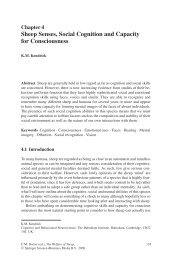Ulric Neisser
Ulric Neisser
Ulric Neisser
Create successful ePaper yourself
Turn your PDF publications into a flip-book with our unique Google optimized e-Paper software.
psychology once, perhaps I could do it again! And if I could, perhaps I should! Ever since the<br />
sudden success of Cognitive Psychology, I have been haunted by something like a sense of<br />
personal responsibility for the future direction of the field.<br />
As one might expect from a lover of the underdog, I soon developed misgivings about the<br />
book that had made me top dog so quickly. In any case, one theoretical problem with Cognitive<br />
Psychology soon became obvious. All the phenomena discussed there are indeed examples of<br />
information processing, but that doesn't mean that they are all the same. In particular, it doesn't<br />
mean that they are all "constructive." The construction metaphor works very well for<br />
remembering and moderately well for identifying briefly-flashed words, but it doesn't work at all<br />
for ordinary perception of the immediate environment. Because I had not thought this through<br />
clearly, the opening pages of Cognitive Psychology included some very questionable rhetoric.<br />
"These patterns of light at the retina are the so-called 'proximal stimuli' ... One-sided in their<br />
perspective, shifting radically several times each second, unique and novel at every moment, the<br />
proximal stimuli bear little resemblance to either the real object that gave rise to them or to the<br />
object of experience that the perceiver will construct as a result" (p.3). As I was shortly to learn<br />
from J.J. Gibson, this is not a good way to describe the real information on which perception is<br />
based. Given that real information, nothing has to be constructed. Simply put, perception is not<br />
the same as hallucination.<br />
In late 1966, when a few pre-publication copies of Cognitive Psychology were already<br />
circulating, I got a call from Harry Levin In Ithaca. Would I consider joining the Cornell<br />
Psychology department as full professor? Yes, indeed I would! At my job talk in Ithaca I liked<br />
the whole scene, though I was puzzled by some of Gibson's questions. (Why, he asked, did I<br />
think that information had to be processed?). The salary offer was a princely $25,000, which I<br />
accepted happily. In 1967 Arden and I moved to Ithaca and bought a big house within walking<br />
distance of the University. Eric and the girls enrolled in the Ithaca schools, and our son Joseph<br />
was born in September.<br />
J.J. Gibson<br />
What next? I was 38 years old and moderately famous. All I had to do from then on, it<br />
would seem, was to keep up with the literature and do occasional experiments. For several<br />
reasons, that was not what happened. For one thing, my ambivalence about computers and<br />
models became ever stronger. I did not like the cognitive psychology that was now taking shape:<br />
there was too much mental chronometry in it, too many conflicting models, too little about<br />
human nature. To be sure I had included one or two of those very models in my book, but there<br />
they had been offset (I thought) by the more humanistic notion of "constructive processes." That<br />
notion no longer seemed to work.<br />
Meanwhile, I was beginning to understand what the Gibsons (J.J. and Eleanor) were up<br />
to. My teaching responsibilities included a course in perception, and two of J.J.'s students - Jim<br />
Farber and John Kennedy - were my first T.A.s. Their reactions to my (very conventional)<br />
approach made it obvious that they knew something I didn't know, but what? It helped when I<br />
began to read Gibson's The Senses Considered as Perceptual Systems (1966), a remarkable book<br />
that had come out not long before. What helped even more was to visit the lab the Gibsons had<br />
established in an old warehouse near the airport, and see the ingenious experiments that were in<br />
progress. Conversations with J.J. helped most of all; there were many occasions for these, both<br />
professional and social. Arden and I often played bridge with the Gibsons, who were delightful<br />
company.<br />
10




